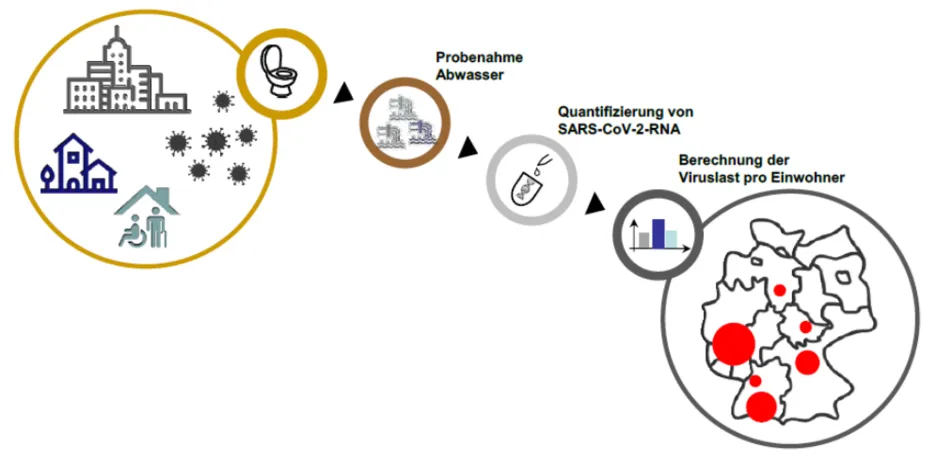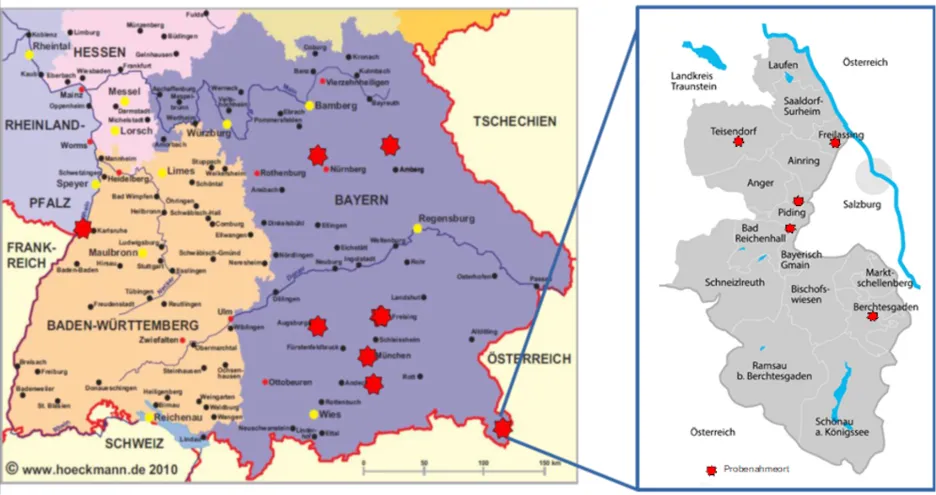Wastewater biomarker CoV2: wastewater epidemiology using the example of a SARS-CoV-2 biomarker for the estimation of COVID-19 infections on the population scale
Wastewater-based epidemiology (WBE) is gaining popularity as a diagnostic method to estimate drug and medication use for entire sewersheds. SARS-CoV-2 can also be used as a biomarker in the context of wastewater diagnostics, on the one hand, to detect a change in the infection pattern at an early stage and, on the other hand, to better elucidate the number of unreported COVID-19 cases at the population scale. Dashboards and automation procedures have been developed for faster data sharing and better networking. This concept enables fast information management and short decision-making paths and is unique.
For the correct estimates of virus concentration in the wastewater, it is also very important to consider other factors, such as population density, the size and coverage of the sewer system, the volume of wastewater generated, degree of extraneous water, and substance-specific variables such as excretion rates, as well as the fate and transport of SARS-CoV-2 in the sewer network. To reduce the uncertainty of the wastewater based monitoring, these factors must be considered when estimating the incidence of infection. The results from this project can be used to develop a novel SARS-CoV-2 biomarker concept that will serve as an early warning system and can also be used to estimate the spread of infection directly by authorities. Such a concept may be extended to an estimation of the incidence of infection by other viruses or its early detection or tracking.
The key objectives of this project are:
- the development of methods for the quantitative determination of SARS-CoV-2 biomarkers, including mutants and viral surrogates, from raw wastewater
- the development and testing of strategies to identify local infection hot spots in a community
- the accurate estimation and prediction of COVID-19 infections in a community based on the presence of enveloped viruses in municipal wastewater; and
- The transferability of the developed methodology and biomarker model to other pathogenic viruses.
To achieve these goals, numerous cities and municipalities in Southern Germany with which we have already gained initial experience in mid-2020 were sampled regularly since October 2020. The map in Figure 2 shows the participating sites. In particular, high-resolution monitoring has been taking place at 5 locations in the county of Berchtesgadener Land in Southeast Germany since October 2020. Here, the recorded virus concentrations in wastewater are correlated with the community-specific case numbers and communicated to the crisis management team within 48 hours. Meanwhile, a ArcGIS-based dashboard has been developed for faster data sharing and better networking. This concept enables fast information management, short decision-making paths and is so far unique in Germany.
SARS-CoV-2 biomarkers can be used as an additional metric for pandemic management in the context of wastewater-based epidemiology. This requires reliable detection of the number of biomarkers in the wastewater, which starts with studying the effects of transport in the sewer system and subsequently taking representative samples.
Sewer system: The transport of SARS-CoV-2 biomarkers in sewers results in biochemical changes which can negatively affect its detection rates in municipal wastewater. In cooperation with the Münchner Stadtentwässerung, we plan measurements in the approx. 9 km long sewer section between the two Munich sewage treatment plants Gut Großlappen and Gut Marienhof and in a shorter sewer section of approx. 300 m in the Munich district of Hasenbergl. Thereby, we will investigate the influence of various factors such as residence time, temperature, pH, and redox ratios on the degradation of SARS-CoV-2 biomarkers in the sewer system.
Diurnal variations: Due to the characteristic excretion behavior, the occurrence of SARS-CoV-2 biomarkers in wastewater is subject to diurnal variations. The diurnal succession pattern is assumed to be related to the amount of population served. To investigate this, we sampled 7 communities with populations ranging from 1.1 million to 8100 connected residents over 48 hours. We analyzed the samples for 4 SARS-CoV-2 biomarkers and other surrogate parameters (PMMoV, flow, ammonium, TOC, el. conductivity, and various trace compounds). Preliminary results show different diurnal patterns of biomarker concentrations for the different communities, as shown in Figure 3.
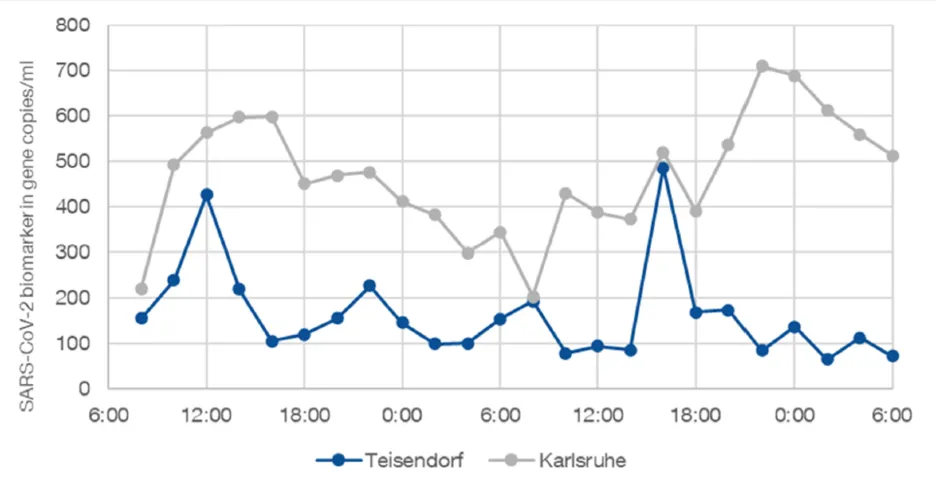
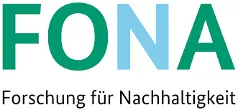
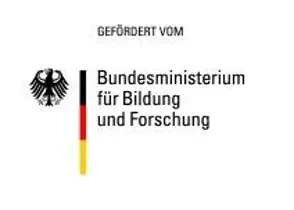




| Project leader | Prof. Dr.-Ing. Jörg E. Drewes |
| Co-lead | Dr. Christian Wurzbacher |
| Responsible for the project | |
| Cooperation partner | TZW DVGW Technology Center Water |
| Project leader | Prof. Dr. Andreas Tiehm |
| Responsible for the project | Dr. Johannes Ho Dipl. -Ing. Claudia Stange |
| SME | Blue Biolabs: Oliver Thronicker |
| Funding | German Federal Ministry of Research and Education (BMBF) |
